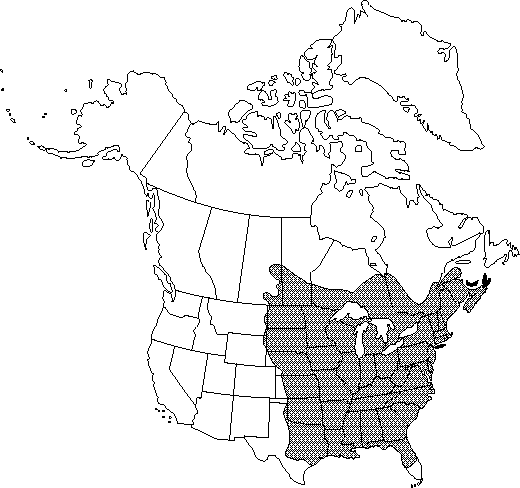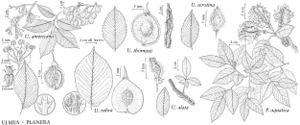Difference between revisions of "Ulmus americana"
Sp. Pl. 1: 226. 1753.
FNA>Volume Importer |
imported>Volume Importer |
||
| (6 intermediate revisions by 2 users not shown) | |||
| Line 13: | Line 13: | ||
}}{{Treatment/ID/Special_status | }}{{Treatment/ID/Special_status | ||
|code=F | |code=F | ||
| − | |label= | + | |label=Illustrated |
}} | }} | ||
|basionyms= | |basionyms= | ||
|synonyms={{Treatment/ID/Synonym | |synonyms={{Treatment/ID/Synonym | ||
| − | |name= | + | |name=Ulmus americana var. aspera |
|authority=Chapman | |authority=Chapman | ||
| − | }}{{Treatment/ID/Synonym | + | |rank=variety |
| − | |name= | + | }} {{Treatment/ID/Synonym |
| + | |name=Ulmus americana var. floridana | ||
|authority=(Chapman) Little | |authority=(Chapman) Little | ||
| − | }}{{Treatment/ID/Synonym | + | |rank=variety |
| − | |name= | + | }} {{Treatment/ID/Synonym |
| − | |authority= | + | |name=Ulmus floridana |
| + | |authority= | ||
| + | |rank=species | ||
}} | }} | ||
|hierarchy=Ulmaceae;Ulmus;Ulmus americana | |hierarchy=Ulmaceae;Ulmus;Ulmus americana | ||
| Line 40: | Line 43: | ||
|elevation=0-1400 m | |elevation=0-1400 m | ||
|distribution=Man.;N.B.;N.S.;Ont.;P.E.I.;Que.;Sask.;Ala.;Ark.;Conn.;Del.;D.C.;Fla.;Ga.;Ill.;Ind.;Iowa;Kans.;Ky.;La.;Maine;Md.;Mass.;Mich.;Minn.;Miss.;Mo.;Mont.;Nebr.;N.H.;N.J.;N.Y.;N.C.;N.Dak.;Ohio;Okla.;Pa.;R.I.;S.C.;S.Dak.;Tenn.;Tex.;Vt.;Va.;W.Va.;Wis.;Wyo. | |distribution=Man.;N.B.;N.S.;Ont.;P.E.I.;Que.;Sask.;Ala.;Ark.;Conn.;Del.;D.C.;Fla.;Ga.;Ill.;Ind.;Iowa;Kans.;Ky.;La.;Maine;Md.;Mass.;Mich.;Minn.;Miss.;Mo.;Mont.;Nebr.;N.H.;N.J.;N.Y.;N.C.;N.Dak.;Ohio;Okla.;Pa.;R.I.;S.C.;S.Dak.;Tenn.;Tex.;Vt.;Va.;W.Va.;Wis.;Wyo. | ||
| − | |discussion=<p>Ulmus americana is reported as widely escaped in Idaho, which is not part of the natural range of this taxon. It is occasionally cultivated outside its native distribution, and it has escaped sporadically from cultivation. It is also reported as naturalized in Arizona, but I have seen no specimens.</p><!-- | + | |discussion=<p><i>Ulmus americana</i> is reported as widely escaped in Idaho, which is not part of the natural range of this taxon. It is occasionally cultivated outside its native distribution, and it has escaped sporadically from cultivation. It is also reported as naturalized in Arizona, but I have seen no specimens.</p><!-- |
| − | --><p>Ulmus americana is the state tree for Massachusetts and for North Dakota.</p><!-- | + | --><p><i>Ulmus americana</i> is the state tree for Massachusetts and for North Dakota.</p><!-- |
| − | --><p>The American elm is susceptible to numerous diseases, including Dutch elm disease. Ulmus americana has been a street and shade tree of choice because of its fast growth and pleasant shape and size. The species still exists in substantial numbers both as shade trees and in nature.</p><!-- | + | --><p>The American elm is susceptible to numerous diseases, including Dutch elm disease. <i>Ulmus americana</i> has been a street and shade tree of choice because of its fast growth and pleasant shape and size. The species still exists in substantial numbers both as shade trees and in nature.</p><!-- |
| − | --><p>Numerous infraspecific taxa have been recognized in Ulmus americana (A. J. Rehder 1949; P. S. Green 1964).</p><!-- | + | --><p>Numerous infraspecific taxa have been recognized in <i>Ulmus americana</i> (A. J. Rehder 1949; P. S. Green 1964).</p><!-- |
| − | --><p>Native American tribes frequently used parts of Ulmus americana for a variety of medicinal purposes, including treatment of coughs and colds, sore eyes, dysentary, diarrhea, broken bones, gonorrhea, and pulmonary hemorrhage, as a gynecological aid, as a bath for appendicitis, and as a wash for gunwounds (D. E. Moerman 1986).</p> | + | --><p>Native American tribes frequently used parts of <i>Ulmus americana</i> for a variety of medicinal purposes, including treatment of coughs and colds, sore eyes, dysentary, diarrhea, broken bones, gonorrhea, and pulmonary hemorrhage, as a gynecological aid, as a bath for appendicitis, and as a wash for gunwounds (D. E. Moerman 1986).</p> |
|tables= | |tables= | ||
|references= | |references= | ||
| Line 53: | Line 56: | ||
-->{{#Taxon: | -->{{#Taxon: | ||
name=Ulmus americana | name=Ulmus americana | ||
| − | |||
|authority=Linnaeus | |authority=Linnaeus | ||
|rank=species | |rank=species | ||
|parent rank=genus | |parent rank=genus | ||
| − | |synonyms= | + | |synonyms=Ulmus americana var. aspera;Ulmus americana var. floridana;Ulmus floridana |
|basionyms= | |basionyms= | ||
|family=Ulmaceae | |family=Ulmaceae | ||
| Line 67: | Line 69: | ||
|publication title=Sp. Pl. | |publication title=Sp. Pl. | ||
|publication year=1753 | |publication year=1753 | ||
| − | |special status=Endemic; | + | |special status=Endemic;Illustrated |
| − | |source xml=https:// | + | |source xml=https://bitbucket.org/aafc-mbb/fna-data-curation/src/2e0870ddd59836b60bcf96646a41e87ea5a5943a/coarse_grained_fna_xml/V3/V3_188.xml |
|genus=Ulmus | |genus=Ulmus | ||
|species=Ulmus americana | |species=Ulmus americana | ||
Latest revision as of 21:46, 5 November 2020
Trees, 21-35 m; crowns spreading, commonly vase-shaped. Bark light brown to gray, deeply fissured or split into plates. Wood soft. Branches pendulous, old-growth branches smooth, not winged; twigs brown, pubescent to glabrous. Buds brown, apex acute, glabrous; scales reddish brown, pubescent. Leaves: petiole ca. 5 mm, glabrous to pubescent. Leaf blade oval to oblong-obovate, 7-14 × 3-7 cm, base oblique, margins doubly serrate, apex acute to acuminate; surfaces abaxially glabrous to slightly pubescent, tufts in axils of veins, adaxially glabrous to scabrous. Inflorescences fascicles, less than 2.5 cm, flowers and fruits drooping on elongate pedicels; pedicel 1-2 cm. Flowers: calyx shallowly lobed, slightly asymmetric, lobes 7-9, margins ciliate; stamens 7-9; anthers red; stigmas white-ciliate, deeply divided. Samaras yellow-cream when mature, sometimes tinged with reddish purple (s range of species), ovate, ca. 1 cm, narrowly winged, margins ciliate, cilia yellow to white, to 1 mm. Seeds thickened, not inflated. 2n = 56.
Phenology: Flowering winter–early spring.
Habitat: Alluvial woods, swamp forests, deciduous woodlands, fencerows, pastures, old fields, waste areas, planted as street trees
Elevation: 0-1400 m
Distribution

Man., N.B., N.S., Ont., P.E.I., Que., Sask., Ala., Ark., Conn., Del., D.C., Fla., Ga., Ill., Ind., Iowa, Kans., Ky., La., Maine, Md., Mass., Mich., Minn., Miss., Mo., Mont., Nebr., N.H., N.J., N.Y., N.C., N.Dak., Ohio, Okla., Pa., R.I., S.C., S.Dak., Tenn., Tex., Vt., Va., W.Va., Wis., Wyo.
Discussion
Ulmus americana is reported as widely escaped in Idaho, which is not part of the natural range of this taxon. It is occasionally cultivated outside its native distribution, and it has escaped sporadically from cultivation. It is also reported as naturalized in Arizona, but I have seen no specimens.
Ulmus americana is the state tree for Massachusetts and for North Dakota.
The American elm is susceptible to numerous diseases, including Dutch elm disease. Ulmus americana has been a street and shade tree of choice because of its fast growth and pleasant shape and size. The species still exists in substantial numbers both as shade trees and in nature.
Numerous infraspecific taxa have been recognized in Ulmus americana (A. J. Rehder 1949; P. S. Green 1964).
Native American tribes frequently used parts of Ulmus americana for a variety of medicinal purposes, including treatment of coughs and colds, sore eyes, dysentary, diarrhea, broken bones, gonorrhea, and pulmonary hemorrhage, as a gynecological aid, as a bath for appendicitis, and as a wash for gunwounds (D. E. Moerman 1986).
Selected References
None.
